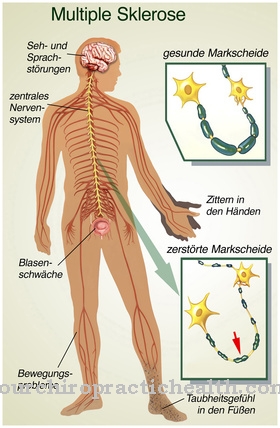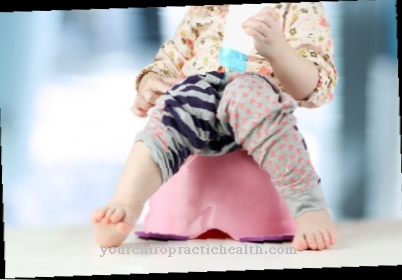Under Hypotonia the doctor understands that muscle tension is too low with simultaneous weakness of the muscles, which is already noticeable in childhood. It always appears as a symptom of an underlying disease and is treated with physiotherapeutic measures.
What is muscle hypotension?

© martanfoto - stock.adobe.com
The term Hypotonia is made up of muscles and the Latin word "hypotonic", which means "reduced strength or tension" and is in itself a very precise description of the symptoms.
Those affected suffer from greatly reduced strength, especially in the striated muscles. This muscle group includes the heart and skeletal muscles, i.e. above all the muscles of the body that are responsible for voluntary, actively controlled movements.
Muscle hypotension becomes noticeable because the person concerned moves very little and has to exert themselves far beyond the normal level when making movements. In childhood, for example, parents notice the child's abnormal exertion when breastfeeding.
causes
The causes of the Hypotonia are versatile, as they always appear as a symptom of other underlying diseases, but never as an independent disease.
As a rule, small children are already affected, which is referred to as infantile muscle hypotonia. The most common underlying diseases include metabolic disorders, the congenital neuromuscular disease nemaline myopathy and neurological diseases, alcohol embryopathy and various other congenital diseases. The most important are briefly presented below.
The Alcohol embryopathy is a disorder that occurs from significant alcohol consumption during pregnancy, usually in children of alcoholic mothers. The symptoms are decreased growth, intellectual retardation, behavioral problems and hypotonia. Muscle hypotonia is also a symptom of congenital trisomy 13 (Pätau syndrome), Edwards syndrome and Down syndrome.
In rare cases, the first manifestation of muscle hypotonia only occurs at an advanced age; autoimmune diseases such as multiple sclerosis or Parkinson's disease or traumatically acquired damage to the central nervous system can then be identified as triggers.
Symptoms, ailments & signs
Muscle hypotonia initially manifests itself through imbalance, muscle hardening and symptoms of paralysis. In the long term there are delays in the development of the musculoskeletal system, which can result in misalignments and muscle pain. The muscle weakness also affects the airways and lungs.
Possible symptoms are speech and swallowing disorders as well as shortness of breath. Some patients have a change in their voice color or a complete loss of voice. If the muscle hypotonia progresses, fatigue syndrome sets in. The child then complains of pain and tiredness after physical exertion, often accompanied by increasing listlessness.
The reduced activity is usually associated with loss of appetite and emotional distress. If the cause of the hypotonia is not treated, the symptoms will progress. This quickly leads to a decrease in quality of life and well-being. In addition, poor posture occurs as a result of weakness, which is associated with further health risks.
Possible consequences of persistent poor posture are joint wear, muscle pain and tension. Muscle weakness can also lead to circulatory disorders and sensory disorders. The blood vessels are also stressed by the reduced muscle activity. If diagnosed early, the symptoms of hypotension will quickly subside. The majority of patients are symptom-free no later than one to two months after treatment of the cause.
Diagnosis & course
Parents usually suspect muscle disorders in small children. A Hypotonia is noticeable by very little movement compared to the age group, great exertion, for example when breastfeeding, and reduced ability to lift the head.
A visit to a pediatrician is urgently recommended in this case. He will take a detailed anamnesis to find out about the symptoms observed by the parents and possible risk factors before he physically examines the child in detail.
The diagnosis is different depending on the age; the patient's posture when standing and walking, lying and sitting, his mobility and motor endurance are relevant. Ultimately, it must also be diagnosed which muscle groups are most affected.
The prognosis of hypotonia depends on the underlying disease; no general statement can be made.
Complications
As a rule, hypotonia itself is a complication. For this reason, the underlying disease that leads to muscle hypotension is primarily treated. The complaint itself can significantly limit the everyday life of the person concerned and lead to complaints when moving and doing various activities. The development of the child is also significantly restricted by the disease.
The patients suffer from severe muscle weakness and thus also from a significantly reduced resilience. The patient's posture is also not straight and can therefore have a negative impact on adulthood and possibly lead to irreversible consequential damage. The muscles appear very weak, so that the person concerned can usually no longer practice various types of sport.
The treatment itself takes the form of treating the underlying disease. As a rule, it cannot be universally predicted whether this will lead to complications. With the help of various therapies, most complaints can be alleviated and limited so that there are no consequential damages in adulthood. The life expectancy of the patient is usually not restricted by the hypotonia.
When should you go to the doctor?
Muscular disorders are considered unusual. If they persist or if the symptoms increase in intensity, a doctor is required. If the general physical performance is reduced, medical advice should be sought. A doctor should be consulted in the event of muscular pain, paralysis or restrictions in natural mobility. If there is a development delay in children, disorders of the swallowing act or problems with sound formation, a doctor should be consulted. Apathy, indifference or a decreased well-being are signs of an existing irregularity.
Clarification by a doctor is necessary as soon as the symptoms persist for several weeks or show an increasing tendency. If the person concerned no longer takes part in usual social activities, mood swings or other behavioral problems occur, a doctor should be consulted. If there is a loss of appetite, an unwanted decrease in body weight or an increased need for sleep, the organism is impaired.
If sleep disturbances occur, if there are abnormalities in the voice or if there are changes in the skeletal system, a doctor is required. In the event of a permanent bad posture or a crooked posture while moving, a timely correction must be made so that there are no lifelong disorders. If the person concerned can no longer participate in normal sporting activities due to the impairment, a doctor should be consulted.
Treatment & Therapy
Treatment of the Hypotonia takes place in two ways: on the one hand, the underlying disease must be treated as well as possible; on the other hand, attempts are made to increase mobility with physiotherapeutic measures.
The underlying diseases can be treated differently depending on their severity and the exact syndrome: While there is no effective therapy for either Edwards syndrome or Pätau syndrome and children with these trisomies have a generally low life expectancy, the chances are for those affected by Down syndrome better.
Those affected have the prospect of almost normal exercise behavior with good early support with curative educational, occupational therapy, physiotherapy and psychomotor procedures. The hypotonia caused by alcohol embryopathy can also be treated so well that affected children can achieve almost normal physical activity.
Physiotherapeutic measures are aimed at improved posture control, conscious fine motor movements and a measured application of force. The exercises to be learned and the duration of the treatment depend on the individual muscle groups affected and the severity of the symptoms.
The exercises can be done on equipment, for example in a roller barrel or on the so-called horse, and without aids and must be carried out daily.
You can find your medication here
➔ Medicines for muscle weaknessOutlook & forecast
With early intervention and occupational and physiotherapy therapies, patients have good prospects of a life with almost normal movement behavior. The therapeutic measures are aimed at improved posture control as well as more conscious fine motor movements with controlled application of force. The learning of the exercises and the duration of the therapy are individually based on the affected muscle parts and the symptoms that occur. These exercises can be done on special equipment and without any aids. Those affected should do the exercises daily. The disease can significantly limit the patient's everyday life.
Muscle hypotonia mainly leads to complaints when moving and when performing various activities. The development of sick children is also very clearly restricted by muscle hypotonia. Those affected suffer from very severe muscle weakness and thus also from a greatly reduced resilience. The posture of those affected is also not straight and thus has a negative effect on later development. The wrong posture can even lead to incurable consequential damage.
In general, the muscles are very weak, so that practicing different sports is usually no longer possible for those affected. With the help of the various treatment methods, however, most complaints can be alleviated so that there are no subsequent consequential damage. As a rule, life expectancy is not restricted.
prevention
Since the causes of the Hypotonia are diverse and not all underlying diseases can be influenced, there are no prevention options. It is advisable to follow a healthy diet that does not harm the child during pregnancy.
Aftercare
In the case of muscle hypotension, the person affected usually has very few and often only limited direct follow-up measures available. For this reason, the person affected should contact a doctor as early as possible so that there are no other complaints or complications. The earlier a doctor is consulted, the better the further course of this disease is usually.
An early diagnosis usually has a positive effect on the further course of the muscle hypotension. Those affected themselves are usually dependent on the measures of physiotherapy and physiotherapy. Many of the exercises can also be done at home to accelerate healing. Parents should also ensure correct posture with their children to alleviate the symptoms.
Those affected by hypotonia are often dependent on the help and support of their own family in everyday life. This can also prevent depression and other psychological upsets. Contact with other patients with the disease can be very useful, as it is not uncommon for information to be exchanged. The disease usually does not reduce the life expectancy of the person affected.
You can do that yourself
Muscle hypotension requires extensive medical treatment and supervision. The most important self-help measure is to regularly adapt drug and physiotherapy therapy to the patient's current state of health. In this way, the progress of treatment can be optimized and, in the long term, the quality of life and well-being of the person affected can be improved.
Provided that there is good early intervention with physiotherapy and psychomotor procedures as well as occupational therapy measures, there is a prospect of normalization of physical activity. However, the patient must do exercises to strengthen the muscles on a daily basis. At the same time, a change or adaptation of lifestyle habits is indicated. Exercise and a healthy and balanced diet are important cornerstones in the treatment of hypotonia.
In addition, the doctor will recommend therapeutic advice to the patient. Talking to a professional can discuss the various problems associated with hypotonia. If desired, the therapist can also establish contact with other affected persons or refer the patient to a self-help group. Regular use of the prescribed medication is also important. An optimally adjusted medication reduces the typical pain and thereby also prevents any secondary diseases such as premature joint wear or poor posture.





.jpg)






















